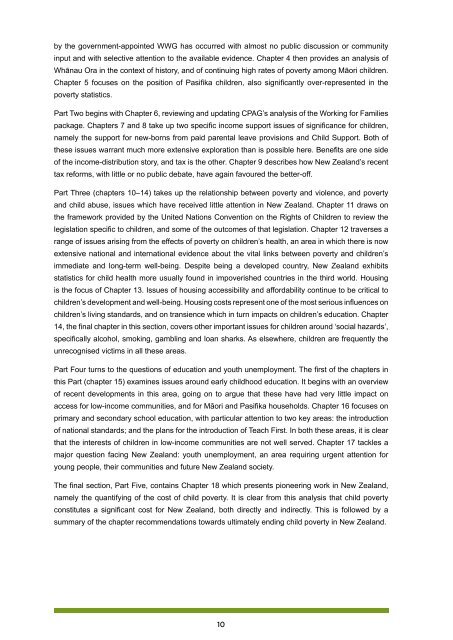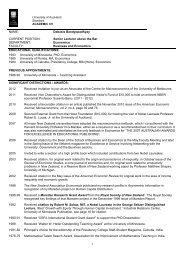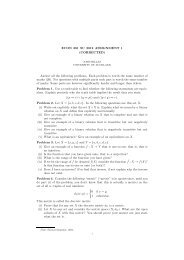Left Further Behind - Child Poverty Action Group
Left Further Behind - Child Poverty Action Group
Left Further Behind - Child Poverty Action Group
Create successful ePaper yourself
Turn your PDF publications into a flip-book with our unique Google optimized e-Paper software.
y the government-appointed WWG has occurred with almost no public discussion or community<br />
input and with selective attention to the available evidence. Chapter 4 then provides an analysis of<br />
Whānau Ora in the context of history, and of continuing high rates of poverty among Māori children.<br />
Chapter 5 focuses on the position of Pasifika children, also significantly over-represented in the<br />
poverty statistics.<br />
Part Two begins with Chapter 6, reviewing and updating CPAG’s analysis of the Working for Families<br />
package. Chapters 7 and 8 take up two specific income support issues of significance for children,<br />
namely the support for new-borns from paid parental leave provisions and <strong>Child</strong> Support. Both of<br />
these issues warrant much more extensive exploration than is possible here. Benefits are one side<br />
of the income-distribution story, and tax is the other. Chapter 9 describes how New Zealand’s recent<br />
tax reforms, with little or no public debate, have again favoured the better-off.<br />
Part Three (chapters 10–14) takes up the relationship between poverty and violence, and poverty<br />
and child abuse, issues which have received little attention in New Zealand. Chapter 11 draws on<br />
the framework provided by the United Nations Convention on the Rights of <strong>Child</strong>ren to review the<br />
legislation specific to children, and some of the outcomes of that legislation. Chapter 12 traverses a<br />
range of issues arising from the effects of poverty on children’s health, an area in which there is now<br />
extensive national and international evidence about the vital links between poverty and children’s<br />
immediate and long-term well-being. Despite being a developed country, New Zealand exhibits<br />
statistics for child health more usually found in impoverished countries in the third world. Housing<br />
is the focus of Chapter 13. Issues of housing accessibility and affordability continue to be critical to<br />
children’s development and well-being. Housing costs represent one of the most serious influences on<br />
children’s living standards, and on transience which in turn impacts on children’s education. Chapter<br />
14, the final chapter in this section, covers other important issues for children around ‘social hazards’,<br />
specifically alcohol, smoking, gambling and loan sharks. As elsewhere, children are frequently the<br />
unrecognised victims in all these areas.<br />
Part Four turns to the questions of education and youth unemployment. The first of the chapters in<br />
this Part (chapter 15) examines issues around early childhood education. It begins with an overview<br />
of recent developments in this area, going on to argue that these have had very little impact on<br />
access for low-income communities, and for Māori and Pasifika households. Chapter 16 focuses on<br />
primary and secondary school education, with particular attention to two key areas: the introduction<br />
of national standards; and the plans for the introduction of Teach First. In both these areas, it is clear<br />
that the interests of children in low-income communities are not well served. Chapter 17 tackles a<br />
major question facing New Zealand: youth unemployment, an area requiring urgent attention for<br />
young people, their communities and future New Zealand society.<br />
The final section, Part Five, contains Chapter 18 which presents pioneering work in New Zealand,<br />
namely the quantifying of the cost of child poverty. It is clear from this analysis that child poverty<br />
constitutes a significant cost for New Zealand, both directly and indirectly. This is followed by a<br />
summary of the chapter recommendations towards ultimately ending child poverty in New Zealand.<br />
10









